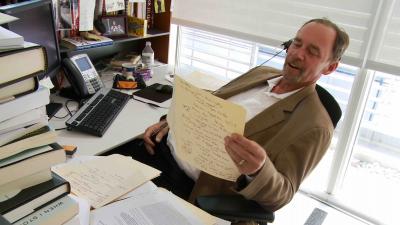Deeper Inside The New York Times

By the end of 2009, it seemed all print media companies were on the verge of collapse. Bankruptcies and layoffs were the common headlines generated by activities happening in the very newsrooms reporting them. Although most of the giants of the daily newspaper game survive to this day, with so much happening that changed the media landscape during the next year, it was a great time to have a camera handy.
Andrew Rossi did. His film “Page One: Inside The New York Times” was the result of a year’s worth of unprecedented access to what is widely considered “the paper of record” at a time of enormous turmoil and change in the newspaper industry. It will be shown tomorrow night at 8 at Guild Hall as part of the Hamptons International Film Festival’s SummerDocs series. Alec Baldwin will host the screening and a question-and-answer session will follow with Mr. Rossi, David Carr, a Times media reporter and columnist, and Bill Keller, the paper’s executive editor.
Mr. Rossi said on Monday that he had decided from the beginning to focus on Mr. Carr. “I envisioned it as a road movie with vignettes on the writers.” Mr. Carr, through his determined championing of the newspaper and his past as a drug addict, made a compelling subject. According to Mr. Rossi, however, “he felt the spotlight too hot on him, so we began to feature more of the writers on the media desk.” These included Brian Stelter, a blogger hired by The Times at age 21, Bruce Headlam, the media desk editor, and Tim Arango, a media reporter who ships off mid-film to cover Baghdad. “David’s role is instructive, but he’s not the exclusive focus.”
According to Mr. Carr, he was happy to talk to Mr. Rossi, “but interviewing other people was challenging because you’re going to get your story, but I won’t get mine.” The glare of the lights had an effect of taming his more impertinent side. There was also the attention it attracted when he went to cover public events. “When someone is following you with a camera, everybody will look and think ‘Who is that jerk?’ ” Covering the interactive portion of the South by Southwest Festival in Austin last year, for instance, was difficult, Mr. Carr said. “It feels dorky after a while.”
He added that the film also shows “editors actually doing their job. I’m a person with a lot of ideas. Some of them are good, but I never know which ones.” He said an editor, and in his case Mr. Headlam, lets him know which stories to tell or more precisely, not to tell.
“The message of the film is the importance of putting out a daily newspaper and the teamwork of many writers and editors coming to work on a daily basis.” Mr. Rossi said Mr. Carr provided continuity and his own backstory acts as a metaphor for the adversity the industry is dealing with and its ability to reinvent itself and survive.
While Mr. Rossi was present when 10 percent of the Times staff were laid off, there were other things happening that caused traditional journalists to take pause, including the advent of Wikileaks and the introduction of the iPad.
Despite the inherent threat in these developments, as it turns out they may have only made the old model stronger. While filming, “We were in the middle of ‘Could this all go away?’ ” Mr. Carr said. That has been replaced by a certainty that the newspaper industry will continue, he said. “We’re not the buggy whip.”
The latest confirmation that good journalism matters has come in the past few weeks, as The Guardian continues to reveal misdeeds by News of the World and British officials, a story the paper had followed over several years despite pressure to stop even by those who are charged with investigating such wrongdoings.
Mr. Carr said it was a demonstration that “the remedy for bad journalism is more journalism.”
New hybrids that offer the investigative journalism that newspapers under financial duress cannot always afford these days are allowing the important investigative work to continue.
Paywalls for Internet content have been shown to be effective, too, and not just because of subscriber revenue. The Wall Street Journal and Financial Times have shown “there’s a new class of Internet advertisers who believe in paying a premium to sell to premium subscribers,” Mr. Carr said.
Both Mr. Carr and Mr. Rossi said that traditional news media was important in making sense of and providing structure for the hundreds of documents released by Wikileaks, to the point where Julian Assange chose to collaborate with The Times, The Guardian, and Der Spiegel in later releases. “It’s all a bunch of text when not organized by a journalist,” Mr. Rossi said.
The title “Page One” has many different meanings, the director said. “It refers to the room where the page one meetings take place, to decide or curate those six or seven stories on the front page. It’s also the evocation that we are on page one and there are many pages to go.” It also recognizes that the idea of a page one, where a package of information is chosen by group of people sitting in a room, is fading away with so many other outlets for those same stories.
With so much footage of daily activity and interviews with journalists in the newsroom, outside media watchers, and industry insiders, Mr. Rossi said it took three people to edit “Page One.” “We pursued a strategy that would elucidate the media’s disruption at the time and tried to make sure we had signposts along the road” to tie it all together.
“Ultimately, I hope the movie will connect with people as a portrait of professionals fighting to do their jobs under the most extraordinary circumstances,” Mr. Rossi said. “I wanted to push past some of the mythologies of journalism.”
